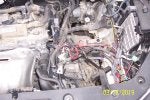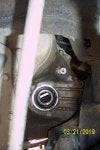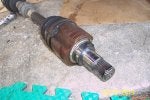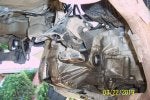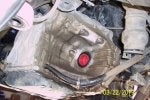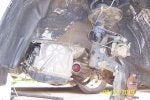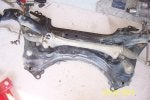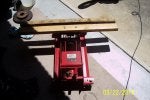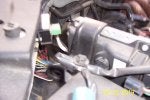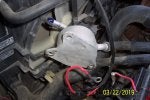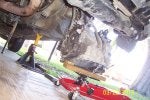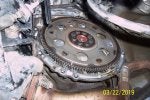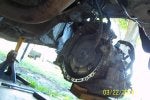I started last week and finally finished today. Vehicle is a 2009 2.5 FWD, 4 cylinder with the 4 speed automatic (U241E). I took out the transmission and replaced the leaking rear main oil seal plus the two transmission axle seals. I did this job a couple of years ago on a Saturn so I pretty much knew what I was getting into. The RAV4 is a little more difficult. I have many years of mechanical experience and tons of tools to get to just about any bolt. I had the overhead engine support and a transmission jack. This is a very risky job unless you know what you are doing. Clearing the top of the transmission in the engine compartment was a couple hour job. You've got the battery, battery tray, air cleaner and box, starter, tranny oil cooler, 4 connectors, gearshift linkage, vacuum line, ground, and a few other things. I broke the upper bell housing bolts loose while the RAV was still on the ground. Then I had to remove the motor mount behind the radiator (very tight).
I bought the Toyota 2.5 engine hanger hooks to use with my transverse engine support system. I loosened the axle nuts and lug nuts before jacking the front up high and supporting the RAV on the frame rails. Then the calipers and rotors come off and lower control arms are separated from the ball joints via 3 fasteners on the bottom. . I drained the tranny fluid and pulled the axles. The left axle has an internal retaining clip and was the toughest to get out. With a carpenters crow bar I was able to unseat it and only damaged the dust shield ring. However, I intended to replace this axle anyhow due to a leaking CV joint boot.
Next was removing the cross member. The tie rod ends and sway bar links come off both sides. The steering column shaft inside the vehicle on the floor must be separated after match marking the position with the steering wheel locked in-place. I rigged up a cradle using my transmission jack (see picture) and supported the entire assembly while removing some pretty large bolts and supporting pieces. Then I carefully lowered it down and rolled it into my garage.
Next, I removed the converter bolts (flex plate to converter) via the tiny opening that Toyota provides. With the engine securely supported overhead, I removed all the affected engine/tranny mounts, except the left one. I rigged up the transmission jack and carefully chained the transmission to the jack. The Transmission is heavily weighted to one side, so it must be secured to the jack. The bolt for the rear mount was pulled and the rest of the bell housing bolts pulled. Then with a pry bar I separated the tranny, carefully lowered it, and rolled it out to the side enough so that I could work on the back of the engine. With my air wrench, I got the flex plate off and noted the different discs that go in front and behind the flex plate. I saw the leaking seal, pried it out and installed a repair sleeve and new seal. That was not easy, but both the sleeve and seal can be installed using one of the heavy discs and the converter bolts with a small stack of washers to take up some of the length. Then the disc can be tightened against the back of the crankshaft and the sleeve and seal pushed in very evenly and square. I prayed I didn't damage it and really won't know for a couple of weeks of driving to check for leaks. I also replaced the transmission shaft seals. From there it begins the massive task of putting things back using the proper torque on most bolts and checking and rechecking the work. Order of assembly is pretty important. On disassembly, I put all common bolts for a certain associated pieces in zip lock bags and carefully labeled them. The Bell housing bolts are different lengths on the top, so I taped and labeled the position of each one so I knew where it went. Throwing all the bolts in a box or on the ground is a recipe for disaster. I got by with that years ago, but not with today's vehicles.
I tried to take some pictures for viewing, but really kept my focus on the job because I was by myself. They are posted below.
I bought the Toyota 2.5 engine hanger hooks to use with my transverse engine support system. I loosened the axle nuts and lug nuts before jacking the front up high and supporting the RAV on the frame rails. Then the calipers and rotors come off and lower control arms are separated from the ball joints via 3 fasteners on the bottom. . I drained the tranny fluid and pulled the axles. The left axle has an internal retaining clip and was the toughest to get out. With a carpenters crow bar I was able to unseat it and only damaged the dust shield ring. However, I intended to replace this axle anyhow due to a leaking CV joint boot.
Next was removing the cross member. The tie rod ends and sway bar links come off both sides. The steering column shaft inside the vehicle on the floor must be separated after match marking the position with the steering wheel locked in-place. I rigged up a cradle using my transmission jack (see picture) and supported the entire assembly while removing some pretty large bolts and supporting pieces. Then I carefully lowered it down and rolled it into my garage.
Next, I removed the converter bolts (flex plate to converter) via the tiny opening that Toyota provides. With the engine securely supported overhead, I removed all the affected engine/tranny mounts, except the left one. I rigged up the transmission jack and carefully chained the transmission to the jack. The Transmission is heavily weighted to one side, so it must be secured to the jack. The bolt for the rear mount was pulled and the rest of the bell housing bolts pulled. Then with a pry bar I separated the tranny, carefully lowered it, and rolled it out to the side enough so that I could work on the back of the engine. With my air wrench, I got the flex plate off and noted the different discs that go in front and behind the flex plate. I saw the leaking seal, pried it out and installed a repair sleeve and new seal. That was not easy, but both the sleeve and seal can be installed using one of the heavy discs and the converter bolts with a small stack of washers to take up some of the length. Then the disc can be tightened against the back of the crankshaft and the sleeve and seal pushed in very evenly and square. I prayed I didn't damage it and really won't know for a couple of weeks of driving to check for leaks. I also replaced the transmission shaft seals. From there it begins the massive task of putting things back using the proper torque on most bolts and checking and rechecking the work. Order of assembly is pretty important. On disassembly, I put all common bolts for a certain associated pieces in zip lock bags and carefully labeled them. The Bell housing bolts are different lengths on the top, so I taped and labeled the position of each one so I knew where it went. Throwing all the bolts in a box or on the ground is a recipe for disaster. I got by with that years ago, but not with today's vehicles.
I tried to take some pictures for viewing, but really kept my focus on the job because I was by myself. They are posted below.


